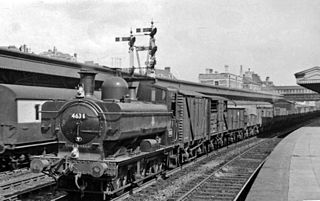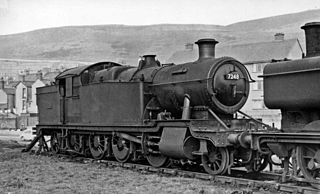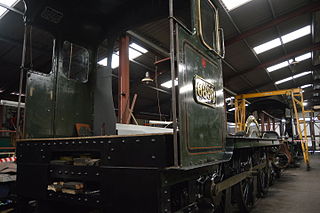
A tank locomotive or tank engine is a steam locomotive that carries its water in one or more on-board water tanks, instead of a more traditional tender. Most tank engines also have bunkers to hold fuel; in a tender-tank locomotive a tender holds some or all of the fuel, and may hold some water also.

The GWR 5700 Class, or 57xx class, is a class of 0-6-0 pannier tank steam locomotive, built by the Great Western Railway (GWR) and British Railways (BR) between 1929 and 1950. With 863 built, they were the most prolific class of the GWR, and one of the most numerous classes of British steam locomotive.

The Great Western Railway (GWR) 6800 Class or Grange Class was a mixed-traffic class of 4-6-0 steam locomotive, built to replace the GWR 4300 Class 2-6-0. There were 80 in the class, all built at the Swindon works, using some reconditioned parts from withdrawn 4300 Class locomotives.

The Great Western Railway (GWR) 6959 or Modified Hall Class is a class of 4-6-0 steam locomotive. They were a development by Frederick Hawksworth of Charles Collett's earlier Hall Class named after English and Welsh country houses.

The Great Western Railway (GWR) 7200 Class is a class of 2-8-2T steam locomotive. They were the only 2-8-2Ts built and used by a British railway, and the largest tank engines to run on the Great Western Railway.

The Great Western Railway (GWR) 4300 Class is a class of 2-6-0 (mogul) steam locomotives, designed by G.J. Churchward for mixed traffic duties. 342 were built from 1911–1932.

The GWR 5600 Class is a class of 0-6-2T steam locomotive built between 1924 and 1928. They were designed by Charles Collett for the Great Western Railway (GWR), and were introduced into traffic in 1924. After the 1923 grouping, Swindon inherited a large and variable collection of locomotives from historic Welsh railway companies, which did not fit into their standardisation programme. GWR boiler inspectors arrived en masse and either condemned the original locomotives or had them rebuilt. The systematic destruction of many examples of locomotives, most still in serviceable condition, followed, but various were worked alongside 5600 Class.

The NBR C Class is a class of 0-6-0 steam locomotives designed by Matthew Holmes for freight work on the North British Railway (NBR). They were introduced in 1888 with inside cylinders and Stephenson valve gear. A total of 168 locomotives was built, of which 123 came into British Railways ownership at nationalisation in 1948. This was the last class of steam engine in service in Scotland.

No.6880 Betton Grange is a steam locomotive which is under construction as a "new-build" project, originally based on the Llangollen Railway in Denbighshire, Wales, then subsequently at Tyseley Locomotive Works. Described as "building the 81st Grange", the project started in 1998, and the locomotive was earlier expected to be operational by 2013, but subsequently by Autumn 2021. All of the original GWR 6800 Class Grange locomotives were withdrawn for scrap by the end of 1965; this project is a creation, from an assemblage of original GWR and newly manufactured components, of a member of this class.

Welsh 0-6-2T locomotives were a standard steam locomotive of the railways of South Wales. Many of the independent railways used them and, at the grouping of 1923, the survivors passed into Great Western Railway (GWR) stock. The GWR perpetuated the type in the GWR 5600 Class. The other major railway company in Wales, the LNWR, also had the LNWR Webb Coal Tank Class, though this was grouped into the LMS not the GWR.
The Barry Railway class H was a small class of seven 0-8-2T tank locomotives built for the Barry Railway by Sharp Stewart in 1896. When they were introduced they were the first locomotives in Britain to use the 0-8-2 wheel arrangement.

Barry Railway Class B1 were 0-6-2T steam tank locomotives of the Barry Railway in South Wales. They were designed by J. H. Hosgood and built by Sharp Stewart, & Co., Vulcan Foundry and Société Franco-Belge. The locomotive, though similar to the B class, differed in having an increased tank capacity of 1,630 gallons compared with the 1,400 gallons of the B class. The purpose of this was to enable them to take a train of empty wagons from Cadoxton Yard to Trehafod Junction without the need to refill the tank.

The South African Railways Class 3 4-8-2 of 1909 was a steam locomotive from the pre-Union era in the Colony of Natal.
Barry Railway Class J were 2-4-2T steam locomotives of the Barry Railway in South Wales. They were designed by J. F. Hosgood, built by both Hudswell Clarke and Sharp, Stewart and Company and were introduced in 1897. Their main use was on the Barry to Cardiff suburban service and had a reputation for always being smartly turned out. They were all shedded at Barry. The locomotives passed to the Great Western Railway in 1922. None survived into British Railways ownership and none have been preserved.
Barry Railway Class G were 0-4-4T steam tank locomotives of the Barry Railway in South Wales. They were designed by J. F. Hosgood, built by both Vulcan Foundry and Sharp Stewart and were introduced in 1892. Initially used for the Barry to Cardiff suburban service, they were transferred to passenger duties on the main line between Barry and Porth as well as the service between Pontypridd Graig and Cardiff Clarence Road, once the 'J' class had displaced them on the Barry to Cardiff run. The company insisted that their passenger locomotives should be smartly turned out and the 'G' class was no exception. The locomotives passed to the Great Western Railway in 1922. None survived into British Railways ownership and none have been preserved.
Barry Railway Class K were 0-6-2T steam tank engines of the Barry Railway in South Wales. They were designed by J. H. Hosgood and built by an American company, Cooke Locomotive and Machine Works of Paterson, New Jersey. At the time the Barry wanted to order these locomotives, British manufacturers already had a full order book. In order not to face an indefinite wait, invitations to tender were advertised in the United States. Hosgood's aim was to have a tank engine equivalent to the “Class B1”. However, because of his desire for a speedy delivery, he agreed to certain compromises in the design. The order was placed in April 1899 and was delivered later that year. Like the 0-8-2 tank locomotives Cooke built for the Port Talbot Railway and Docks Company around the same time, the engines had the clean lines and uncluttered appearance of British practice, but had bar frames, the front buffer beam separate from the footplate, as well as cylinder and saddle designs typical of American pactice.
Barry Railway Class F were 0-6-0ST steam saddle tank engines of the Barry Railway in South Wales. They were designed by J. H. Hosgood and built by a number of British companies.
Barry Railway Class E were 0-6-0T steam locomotives of the Barry Railway in South Wales. They were designed by J. H. Hosgood and built by Hudswell Clarke. The locomotive was designed for light shunting duties at the docks. Their small size made them particularly suited to shunting on the Barry Island Breakwater. Access to the breakwater was via a rough hewn tunnel whose dimensions and sharp curves made it impossible for the other locomotives to negotiate a way through.
Barry Railway Class C were originally 2-4-0T steam locomotives of the Barry Railway in South Wales. They were designed by J. H. Hosgood and built by Sharp Stewart.
Barry Railway Class A were the first steam tank engines to be built for the Barry Railway in South Wales and had an 0-6-0T wheel arrangement. They were designed by John Wolfe Barry and built by Sharp Stewart.











